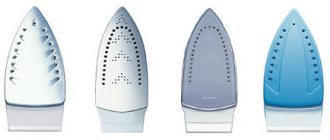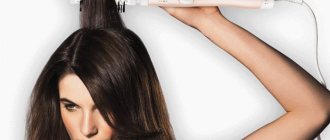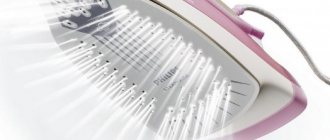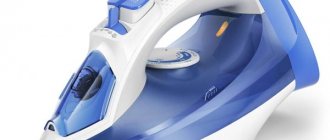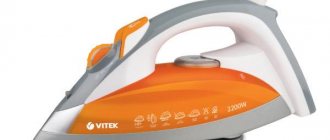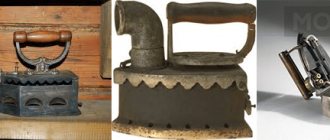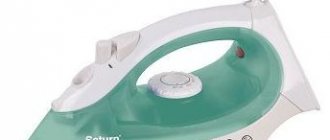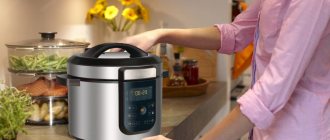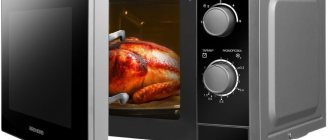Temperature modes: deciphering the points on the temperature controller
If the wrong ironing setting is selected, nylon or chiffon fabric may be washed, while linen or cotton fabric may become wrinkled.
To allow the user to select the desired temperature, the iron was equipped with a "knob" or "rotating wheel" that adjusted the thermostat. Images corresponding to a certain temperature regime were applied to the pen. In most cases these are points. The more there are, the greater the heating temperature of the sole surface. The selected temperature regime must comply with the rules for caring for the item. For user convenience, they are printed on product labels in the form of images. The dots are also repeated on the graphic rules: one, two or three. Such images are not random, each means a certain way of ironing the iron.
Two
For perfect ironing of the most heat-resistant fabrics, you need to set the wheel to 2 points. This temperature setting is suitable for:
- wool mixture.
- wool,
- polyester;
The exposure temperature will be up to 150 (you can often find the designation “wool” nearby (for wool).
Ironing with steam is also possible.
One
Single mode means that the heating temperature is suitable for ironing delicate fabrics:
- viscose,
- nylon.
- polyamide,
- chiffon,
- nylon
- silk
- acetate,
The material will be exposed to temperatures up to 110 ˚С.
Sometimes the words “nylon” and “silk” appear next to it, confirming the choice of the most delicate modality.
Three
Fabrics require maximum heat when ironing:
- tweed,
- drapery.
- cotton,
- wool,
Thermal impact reaches 200. The ironing process is facilitated by the possibility of exposure to steam.
What do other names for heat treatment mean?
The remaining methods are presented in the table:
Although there are no such marks on the device itself, they clarify: once you turn on the steam, at what number of “spots” to stop when ironing.
Recommendations for choosing ironing temperature for different fabrics
A situation often arises when there is no label with recommendations for caring for things. In these cases, practical advice will come in handy.
Linen
The item must first be poured out of the mold and ironed at a temperature of 180-200 ° C. The best result is obtained when the fabric is damp. When ironing, don't be afraid to press down on the iron and use steam.
If the item is made of cotton blend, the iron should not be heated above 180 ° C. It is worth considering that decorative elements (for example, embroidery) are often made of synthetic materials, so they should only be ironed from the inside.
What happens if the material is very dense and does not stretch properly? Such items are additionally ironed on the front side, possibly at the same temperature, but always through gauze. If the product is starched, the temperature should be reduced by 10-20 degrees.
Wool
Wool does not tolerate high temperatures well, so the optimal mode is 100 - 120 ° C. This applies to woven wool and it is better not to iron knitted products at all. If you really want to iron your favorite sweater, you need to do it from the inside, without pressing the iron, so as not to stretch the material. A wool coat is ironed at 140-170°C, again with steam.
Cotton
This material must be ironed at a temperature of 170 - 180 degrees. Like linen, cotton is best handled when it is not completely dry or has been dampened with a spray bottle. Can be steamed.
Silk
This is a very delicate material that needs to be ironed as carefully as possible. Does not tolerate temperatures above 60 - 80 ° C, as well as steam. If you need to iron the fabric, you should use thin cotton rather than gauze (it can leave unsightly marks on the silk product). When processing through fabric, the temperature can be increased by 20 ° C.
Viscose
Maximum temperature 120°C, light steam allowed.
Knitwear
Temperature – medium or minimum. To prevent the fabric from stretching, it is better to steam the knitwear in a vertical position rather than ironing it.
How many degrees does the iron heat up to?
For fabrics that are more difficult to iron, it is necessary to use a maximum iron heating temperature in degrees equal to 205 ° C. In this case, the heating rate will depend on the type of material from which the sole of the iron is made and the power of the electrical appliance.
Heating rate depending on sole material
The sole consists of:
- Aluminum. Heating occurs very quickly, and cooling also occurs, but the material is short-lived. Hard elements on clothing can leave scratches in which burnt fabric particles become embedded.
- Made from stainless steel. It heats up quickly, glides well over the surface and is durable. The disadvantage is the heavy weight of the device.
- Ceramic. This coating is applied to a metal base. It glides perfectly, allows you to iron fabric in hard-to-reach places, and does not stick to clothes. Heating and cooling take longer. Ceramic retains heat, so even when turned off, the iron will last 8-10 minutes and remains hot. The disadvantage is the fragility of ceramics, the tendency to chip and damage. To extend service life, manufacturers use cermets.
- Teflon - reliably protects clothes from burning, but does not last long. The Teflon surface does not glide well over fabric, making ironing difficult.
- Sapphire is a specially developed alloy that gives the sole extra strength. Conducts heat well.
- Titanium is rarely used in the manufacture of household irons. The metal will heat up quickly and take a long time to cool down. The surface strength is not inferior to steel.
Maximum temperatures may vary between models, so please read the instructions before selecting a mode.
If the iron has only one heat setting, no spray or steam function, the temperature of the soleplate of the iron will be 115 ° C (± 10).
Irons are a little warmer - about 155˚C.
Electrical appliances with steam treatment reach temperatures of 175-205 ˚C.
Influence of electrical appliance power
The rate of heating of the surface, the possibility of creating a “cloud” of steam, the rate of cooling of the sole directly during ironing depend on the power of the iron.
In domestic models, the power varies from 800 to 2200 W. Models not equipped with a thermostat and humidifier have lower power, within 400 W. Ironing them is much more difficult; they heat up more slowly and cool down quickly.
Advice! For home use, an iron with a power of 1500 to 2200 W is suitable. For those who like to iron a large number of things with maximum comfort, models with a power close to 2700-2800 W are suitable, but it is necessary to ensure that the wiring can withstand such voltage and not to turn on several electrical appliances at the same time.
Long-term professional ironing, for example, in a laundry or dry cleaning service, will require the purchase of a more expensive and powerful device, from 2800 W. Heating in such models occurs as quickly as possible, and the steam boost is extremely powerful (about 230 g / min).
Minimum iron temperature
To select the lowest temperature, select the silk (single dot) ironing setting. The minimum ironing temperature is 75 ° C.
In irons without a thermostat, the heating temperature is about 115 °C. Since it is impossible to select a delicate processing mode for the product, it is necessary to start ironing from the wrong side, moistening the fabric.
When straightening items that cannot be ironed, even the mode set to one stitch can ruin it. To safely process fabric you must:
- iron by placing the item between two layers of fabric: dry on the bottom, damp on the top.
- exposed to steam;
- moisten with a spray bottle and hang for leveling;
Advice! Before steaming, make sure there are no rust particles or water droplets coming out of the nozzles, which could leave streaks. The removable nozzle plate prevents dirt from entering.
Steam temperature in the iron
The steam helps moisturize the clothes and makes them much easier to iron, but for particularly wrinkled areas a “shot of steam” is used. The range depends on the power of the iron.
In domestic models, the steam force is about 20-25 g/min. More professional equipment allows you to work with steam supplied at an intensity of 160 g/min. In this case, the steam temperature reaches 160-210 ˚C, depending on the characteristics of the model.
How to choose the right iron for your home
When choosing this home assistant, it is important to pay attention to its design and various functional additions:
- The working plane of the iron that comes into contact with the fabric when ironing is called the sole. Its characteristics largely determine the functionality of this electrical device. Therefore, it is important to pay attention to this when purchasing. The sole can be made of aluminum, steel or cermet. The cost of the electrical appliance also depends on the material of the sole.
- Steam humidification function, which can help quickly and thoroughly iron any fabric. Here it is important to estimate the volume of the water tank, which can range from 200 to 400 ml.
- Water sprinklers are needed to moisten things before ironing in cases where it is absolutely impossible to treat them with steam. Moreover, it is necessary to use only purified water so as not to leave dirty stains on clothes.
- The “forgetful” function, when using a special sensor, will help protect both clothing and the iron itself (after 20-30 seconds of inactivity in a horizontal position or several minutes of inactivity in a vertical position, the iron automatically turns off).
It is also necessary to pay attention to the electricity consumption of the device, that is, the power consumption of the iron, which can significantly affect the rate of heating of the soleplate and the process of steam formation:
- Iron models with a power of less than 1500 W (1.5 kilowatts) are usually small in size and are classified as convenient travel models. They do not have a steam function.
- Electric irons with a power of 1500-2000 W (1.5-2 kW) are suitable for a small number of items that require ironing.
- You should choose irons with a power of over 2000 W (2 kW) if you constantly iron many things at once. With the built-in steam generation function, the speed and quality of ironing will be significantly higher. Such models are more related to professional ironing devices than to home ones.
Before you buy the most powerful iron, find out in advance how much voltage is in your electrical network and whether it corresponds to this power.
If you need to purchase an electric iron for daily use with small amounts of clothing, you should choose models with a power of 1.4 - 1.5 kW. Do not also forget about the compliance of the power and capabilities of the electrical network of your home. It is very important to consider how much electricity the iron consumes and what additional functionality it has.
What do the numbers or dots on the electric iron panel mean?
The power of the iron affects the heating temperature of its soleplate, as well as the heating speed. For modern home models, the power is usually in the range of 1400-1900 W (1.4-1.9 kW). The most common power is considered to be 1400-1500 W (1.4-1.5 kW), which is quite suitable for ironing jeans or shirts.
The temperature range is usually marked with dots or numbers on the iron panel.
One dot or number 1 on the panel indicates:
- The maximum temperature is 115C.
- Minimum temperature – 75C.
- Nominal - 95C.
Two dots or number 2 shows the temperature:
- Maximum – 155C.
- Minimum – 150C.
- Nominal - 130C.
Three dots or the number 3 on the panel indicate the temperature:
- Maximum – 205C.
- Minimum – 145C.
- Nominal - 175C.
What material are the soles made of?
In order for the ironing result to be ideal, the soleplate of any electric iron must be heated evenly. Devices with ceramic surfaces have this ability. There are also irons with metal (aluminum, steel, cast iron) soles. They are characterized by good glide, good heat capacity, and strength.
Most modern irons have built-in thermostats, tubular electric heaters (TEHs) and signal lamps. More expensive models are equipped with steam humidifiers. However, all this functionality has no practical effect on the heating temperature of the soleplate of the electric iron. So in order to determine what temperature to set for ironing things, it is better to focus on the above ranges.
About optimal temperature conditions
Each type of fabric has its own ironing modes, allowing you to bring your clothes into decent shape without harming them. All iron models are now equipped with a temperature control function based on the type of fabric. And for this you need to know at what temperature this or that thing should be ironed.
Advice. Almost every item has special labels with a note indicating at what temperature the item can be ironed.
If there are no labels, but the material from which this item is made is known, you can use general recommendations. Knowing the maximum and minimum heating temperatures of the iron sole (205 and 78, respectively), and having an understanding of the material of the product, you can easily select the optimal mode for ironing.
How to choose the right iron for your home
When choosing this home assistant, it is important to pay attention to its design and various functional additions:
- The working plane of the iron that comes into contact with the fabric when ironing is called the sole. Its characteristics largely determine the functionality of this electrical device. Therefore, it is important to pay attention to this when purchasing. The sole can be made of aluminum, steel or cermet. The cost of the electrical appliance also depends on the material of the sole.
- Steam humidification function, which can help quickly and thoroughly iron any fabric. Here it is important to estimate the volume of the water tank, which can range from 200 to 400 ml.
- Water sprinklers are needed to moisten things before ironing in cases where it is absolutely impossible to treat them with steam. Moreover, it is necessary to use only purified water so as not to leave dirty stains on clothes.
- The “forgetful” function, when using a special sensor, will help protect both clothing and the iron itself (after 20-30 seconds of inactivity in a horizontal position or several minutes of inactivity in a vertical position, the iron automatically turns off).
It is also necessary to pay attention to the electricity consumption of the device, that is, the power consumption of the iron, which can significantly affect the rate of heating of the soleplate and the process of steam formation:
- Iron models with a power of less than 1500 W (1.5 kilowatts) are usually small in size and are classified as convenient travel models. They do not have a steam function.
- Electric irons with a power of 1500-2000 W (1.5-2 kW) are suitable for a small number of items that require ironing.
- You should choose irons with a power of over 2000 W (2 kW) if you constantly iron many things at once. With the built-in steam generation function, the speed and quality of ironing will be significantly higher. Such models are more related to professional ironing devices than to home ones.
Before you buy the most powerful iron, find out in advance how much voltage is in your electrical network and whether it corresponds to this power.
If you need to purchase an electric iron for daily use with small amounts of clothing, you should choose models with a power of 1.4 - 1.5 kW. Do not also forget about the compliance of the power and capabilities of the electrical network of your home. It is very important to consider how much electricity the iron consumes and what additional functionality it has.
For each type of fabric, a certain ironing mode is set, with which you can bring the product into proper shape without damaging it. Experienced housewives know that the temperature of the iron is regulated, and the desired degree of heating of the sole is set, taking into account the type of material from which the item is sewn, as well as the texture of the applied pattern (if any).
How to find out the temperature of the iron
The easiest way to find out the temperature of the iron is by points. However, it happens that when ironing delicately, the item “burns”, or at the maximum setting the sole remains not hot. Perhaps the reason is a broken thermostat. You can check the heating temperature of your iron using high-temperature thermometers. It is enough to buy a digital or mechanical device that allows you to measure temperatures up to 300 ° C, because irons do not have higher temperatures. The cost of meters is 200 rubles. More expensive are infrared pyrometers (from 1000 rubles), which allow you to measure temperature without direct contact with the object. Such a device is useful for measuring liquids, food, electric heaters and other items.
There are also “popular” verification methods:
- Sprinkle with iron and wait until it sizzles. This means the temperature is above 100˚C.
- Natural iron wool. If the fibers become dry and brittle, the temperature approaches 105 ° C, and if an unpleasant smell of burnt hair appears, the heating has reached 120.
In order not to risk your favorite things, it is important to know exactly what temperature the plate has reached. It is better to experiment, but to buy a device with a thermostat, follow the instructions for use and read the labels on the clothes before ironing. If you suspect a malfunction, measure t with a special thermometer and repair the electrical appliance in accordance with the warranty card.
Table of ironing temperature conditions for various types of fabrics
| Textile | Temperature | Steam | Iron pressure | Fabric characteristics |
| Pure cotton | 140 - 170 degrees | wet steam | iron under strong iron pressure | need for hydration |
| Cotton with polyester blend | 110 degrees | small amounts of steam | general | cm cotton, polyester |
| Polyester | “minimum” or “silk” temperature regime | no steam | lung | iron with a slightly heated iron, as the material melts easily |
| Products with compressed effect | 110 degrees | no steam | general | — |
| Viscose | 120 degrees, “silk” temperature | a little steam | general | Viscose should not get wet, as there is a high risk of water stains. Iron slightly damp viscose only on the reverse side or through a thin fabric dampened on the reverse side. |
| Cotton fabric with linen | 180 degrees | many couples | strong iron pressure | cm cotton, linen |
| Linen fabric | 180-200 degrees | many couples | strong pressure | It is necessary to iron clothes with a hot iron from the inside, using a humidifier |
| Silk | 60-80 degrees | — | general | Silk is examined with a dry iron, through a thin damp cloth, but not with gauze (it will leave marks); iron on the petal thread (vertically) so that the product does not iron. When ironing, further moistening is impossible - stains will remain. |
| Nylon | Better just a ferry. But if necessary, gently iron at 60-80 degrees | vertical steam ironing | — | Nylon usually does not need to be ironed after washing. The material melts: all nylon products are very sensitive to heat |
| Chiffon | 60-80 degrees, gentle low temperature ironing | no steam | light iron pressure | Do not spray clothes with a spray bottle (water may stain). Iron with damp gauze. The soleplate of the iron should be homogeneous, without sticking particles - there may be puffs left on delicate fabrics. |
| Wool and semilane | 100-120 degrees on fabric | vertical steaming of wool is preferable to ironing | lung | - iron the wool with a damp cotton cloth; — steam iron for clothes with embossing; - Do not iron clothes made of soft wool. |
| Denim | Roughness: 180-200 degrees, soft cotton jeans: 150 degrees | steam | strong | Jeans should be ironed inside out when they are still slightly damp. From the front side - through gauze or fabric. |
| Tweed | 140-170 degrees from the seam side through a damp cloth | many couples | — | t the look is better not to iron, but to steam using a vertical steamer |
| Drapery | 140-170 degrees, but best with a steam iron or steam cleaner | many couples | — | difficult to iron, better to steam |
| Chintz | 140 - 170 degrees, use steam iron at maximum temperature | many couples | strong pressure | iron from front, pre-moisten |
| Sponge (towels, sheets, bathrobes) | Do not iron | — | — | ironing becomes harsh and does not absorb moisture well |
| Sweater | minimum or average temperature | Correctly iron knitwear with a steam iron in a suspended state | do not press so as not to crush the fibers | ironing should be done in the direction of the loops on the sewn side |
Ironing temperature
Always set according to fabric type. It is best to start with the lowest temperatures, increasing as necessary if necessary.
Many manufacturers anticipate housewives’ doubts about choosing the ironing temperature, and instead of degrees they write prompts on the iron relay: “cotton”, “linen” and so on. And if you put the iron in steam mode, there will be fewer wrinkles on the fabric.
Be sure to iron any fabric a couple of times - suddenly the soleplate of the iron leaves stains and traces of water that can accidentally get onto your item of clothing.
First of all, pay attention to the labels on the clothes: they contain all the information on caring for the product: how to wash, how to dry and, finally, at what temperature to iron:
The label is lost - no problem, the table of ironing modes will tell you at what temperature you need to iron this or that fabric:
About optimal temperature conditions
Each type of fabric has its own ironing modes, allowing you to bring your clothes into decent shape without harming them. All iron models are now equipped with a temperature control function based on the type of fabric. And for this you need to know at what temperature this or that thing should be ironed.
Advice. Almost every item has special labels with a note indicating at what temperature the item can be ironed.
If there are no labels, but the material from which this item is made is known, you can use general recommendations. Knowing the maximum and minimum heating temperatures of the iron sole (205 and 78, respectively), and having an understanding of the material of the product, you can easily select the optimal mode for ironing.
Selecting the correct ironing mode based on the icons on clothes
The maximum possible heating of the device is 205 degrees, and the minimum value is 110. This is enough to iron a product made of any fabric without damaging it.
Before you start working on an item, you should study its etiquette. It should have one of these icons on it.
Important! This information allows you to understand what mode you need to set on the iron to iron a particular product.
Sometimes there is no medication label on the article. In such cases, you should focus on the type of fabric from which it is sewn.
- Wool. Before ironing, the linen product must be turned over and ironed at a temperature of 180-200 degrees. To achieve an ideal result, it is necessary not only to set the above value on the regulator, but also to slightly moisten the material. Don't be afraid to apply pressure and use steam. If cotton is present along with linen, it is not recommended to heat the soleplate of the iron above 180 degrees. You should also take into account the presence of decorative elements made of synthetic materials, which can only be processed from the reverse side.
- Wool. Woolen clothes do not tolerate high temperatures well, so the regulator should be set to a value at which the sole heats up to 100-120 degrees.
- Cotton. Cotton fabrics should be ironed at a temperature of 170-180 degrees. It is recommended to moisturize the material to eliminate wrinkles. You can use the steam function.
- Silk. Items made from delicate fabrics are ironed very carefully. Temperatures above 60-80 degrees and steam are unacceptable.
- Viscose. The maximum temperature is 120 degrees. You can vaporize an item in moderate quantities.
- Knitwear. It is recommended to iron products made from this material at minimum and medium temperatures. To prevent clothes from becoming deformed, use the vertical steam function.
- Nylon. Nylon fabric is quite extravagant and ironing is not recommended. If folds appear on the product, before ironing it, you need to set the regulator to a position of 60-80 degrees, no more.
Sources
- https://telewizori.ru/uborka/temperatura-utyuga-gradusov.html
- https://KiguHome.ru/domashnyaya-tehnika/temperatura-utyuga.html
- https://VseShokeri.ru/dom/maksimalnaya-temperatura-utyuga.html
- https://tehnovedia.ru/utyugi/temperatura-utuga/
- https://KTexnika.ru/uborka/temperatura-utyuga-po-tochkam.html
- https://my-pic.ru/tehnika/temperatura-utyuga-po-tochkam.html
- https://coppeer.ru/kakoj-temperature-sootvetstvujut-tochki-na-utjuge/
How to choose the correct iron temperature for ironing
For each type of fabric, a certain ironing mode is set, with which you can bring the product into proper shape without damaging it. Experienced housewives know that the temperature of the iron is regulated, and the desired degree of heating of the sole is set, taking into account the type of material from which the item is sewn, as well as the texture of the applied pattern (if any).
Explanation of symbols on the thermostat knob
The temperature control function allows you to set the switch to one of three positions. A modern iron, like a Soviet one, has 3 symbols: one, two and three dots. Each of them determines the heating temperature of the working surface of the device. In some cases, modes are designated not by points, but by type of fabric. To make it easier to navigate, some manufacturers indicate the type of material next to the dots:
- one point – low degree of heating – “Silk”;
- two – medium – “Wool”;
- three – high – “Cotton”.
Some models may have the inscription “Nylon” slightly below the original value. When the switch is set to this position, it limits the heating temperature of the sole to the minimum possible, so that products made from synthetic threads can be processed.
Minimum and maximum heating temperature
The working surface of the iron is made of:
The aluminum sole requires a minimum amount of time to reach the desired temperature. Models with cast iron and steel working surfaces heat up quite quickly. Devices with metal-ceramic or ceramic soleplates gain temperature more slowly and take longer to cool down.
Important! When purchasing an iron, you should consider not only the speed, but also the uniformity of heating of the soleplate. Both of these indicators affect the quality and convenience of ironing.
The speed at which the minimum and maximum temperatures are reached depends on:
- established mode;
- electrical appliance power;
- the material from which the working surface of the device is made;
- the presence or absence of a steam generation system.
The average heating speed of an iron varies from three to eight minutes. If you measure the temperature of the sole, you can draw the following conclusions:
- Devices with a power of 2.5 kW or more have the highest heating rate;
- if the device power is in the range from 0.8 to 1.3 kW, then heating will be slow.
The power of the iron must correspond to the capabilities and technical condition of the electrical network to which it will be connected.
Selecting the correct ironing mode based on the icons on clothes
The maximum possible heating of the device is 205 degrees, and the minimum value is 110. This is enough to iron a product made of any fabric without damaging it.
Before you start processing an item, you should study its label. It should have one of these icons on it.
Important! This information allows you to understand what mode you need to set on the iron to iron a particular product.
Sometimes items do not have a care label. In such cases, you should focus on the type of fabric from which it is sewn.
- Linen. Before ironing, a linen product should be turned inside out and ironed at a temperature of 180–200 degrees. To achieve ideal results, it is necessary not only to set the above value on the regulator, but also to slightly moisten the material. Don't be afraid to put pressure on an electrical appliance or use steam. If the composition contains cotton along with linen, then heating the soleplate of the iron above 180 degrees is not recommended. You should also take into account the presence of decorative elements made of synthetic materials, which can only be processed from the wrong side.
- Wool. Woolen items do not tolerate high temperatures, so the regulator should be set to a value at which the sole heats up to 100–120 degrees.
- Cotton. Cotton fabrics should be ironed at a temperature of 170–180 degrees. It is advisable to moisten the material to get rid of wrinkles. You can use the steam function.
- Silk. Items made from delicate fabrics are ironed very carefully. Temperatures exceeding 60–80 degrees and steaming are unacceptable.
- Viscose. The maximum temperature is 120 degrees. You can moderately steam the item.
- Knitwear. It is recommended to iron products made from this material at minimum and medium temperatures. To prevent the item from becoming deformed, you should use the vertical steam function.
- Nylon. Nylon fabric is quite finicky; ironing it is not recommended. If creases appear on the product, then before treating it with an iron, you need to set the regulator to a position of 60–80 degrees, no more.
The most reliable irons of 2021
Iron Bosch TDA 3024010 on Yandex Market
Iron Philips GC2990/20 PowerLife on Yandex Market
